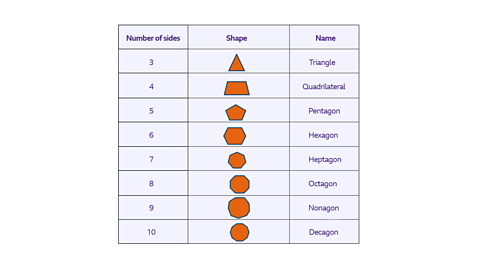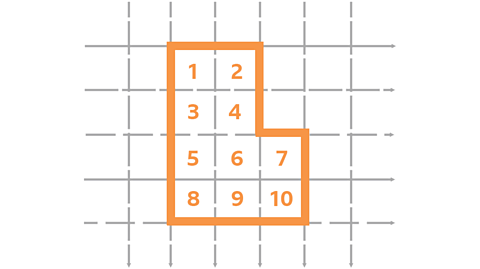Two dimensional (2D) shapes
All 2-D shapes are flat. They can have any number of sides that meet up with no gaps.
Some have straight sides.
Some have curved sides.
And some have both straight and curved sides.
2D shapes with all sides equal in length and all angles equal are called regular shapes.
Polygons are 2D shapes with straight sides.

Triangles
A triangle is a 2-D shape with 3 straight sides.
There are 4 types of triangles: scalene, right-angled, isosceles and equilateral.
Scalene triangle
- No sides equal in length
- All angles different
- No lines of symmetry
Right-angled triangle
- One angle equal to 90°
Isosceles triangle
- Two sides equal in length
- Two angles equal in size
- One line of symmetry
Equilateral triangle
- Regular triangle
- All sides equal in length
- All angles equal to 60°
- Three lines of symmetry
The sum of the angles in any triangle is 180°.
If 2 of the angles in a triangle are known the 3rd angle can be calculated in two steps:
- add together the other 2 angles
- subtract the total from 180
Example
Calculate the size of angle a.
- add together the other 2 angles
62 + 41 = 103
- subtract the total from 180
a = 180 – 103
a = 77°
Example
Find the size of angle b in the isosceles triangle.
The sum of the angles in a triangle is 180°
The two angles at the base are equal
2b = 180 – 42 = 138
b = 69°
Question
Calculate the missing angle k and name the triangle.
k = 180 – (48 + 66)
k = 66°
The triangle has 2 equal angles, it is an isosceles triangle.
Quadrilaterals
A quadrilateral is any 2-D shape with 4 straight sides.
Some quadrilaterals have special properties.
Square
- Regular quadrilateral
- All sides equal in length
- All angles equal to 90°
- Opposite sides are parallel
- Four lines of symmetry
Rectangle
- Opposite sides equal in length
- All angles equal to 90°
- Opposite sides are parallel
- Two lines of symmetry
Parallelogram
- Opposite sides equal in length
- Opposite angles equal in size
- Opposite sides are parallel
- No lines of symmetry
Rhombus
- All sides equal in length
- Opposite angles equal in size
- Opposite sides are parallel
- Two lines of symmetry
Trapezium
- One pair of opposite sides is parallel
The sum of the angles in any quadrilateral is 360°.
If 3 of the angles in a quadrilateral are known the 4th angle can be calculated in two steps:
- add together the other 3 angles
- subtract the total from 360
Example
Calculate the size of angle d.
- add together the other 3 angles:
242 + 59 + 43 = 344
- subtract the total from 360:
360 – 344 = 16
d = 16°
Question
Calculate the size of angle x.
Find the missing angle inside the quadrilateral:
360 – (110 + 130 + 48) = 72°
This angle is on a straight line beside x.
x = 180 – 72 = 108°
x = 108°
Test yourself
More on M1: Geometry and measures
Find out more by working through a topic
- count1 of 9
